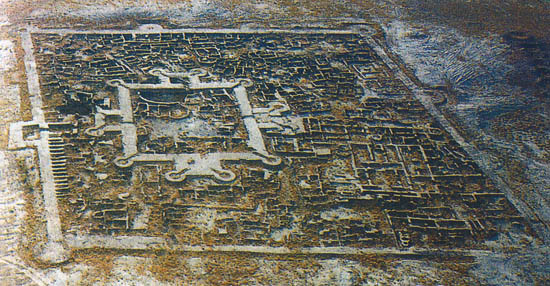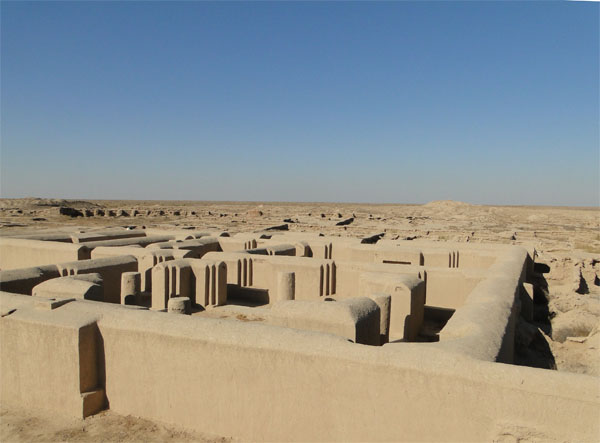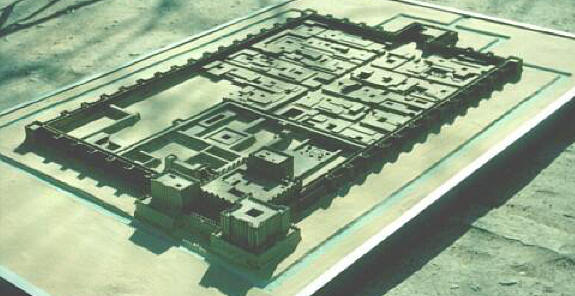Gonur, Bactria Margiana Archaeological Complex
May 13, 2015 10:59:39 GMT
nostranger, Hill, and 4 more like this
Post by geven46 on May 13, 2015 10:59:39 GMT
Gonur Bactria Margiana Archaeological Compl....kmz (1.91 KB)![]()
The impressive size of the excavated remains of Gonur leads archaeologists to consider this the main city of the vast Bactria Margiana Archaeological Complex. This is the ancient Bronze Age civilization known as the Oxus Civilization, after the great Central Asian river, the Oxus, also known as Amu Darya.
Gonur and other fortified towns and settlements are in a region now covering the modern states of Turkmenistan, Uzbekistan, Tajikistan, northern Afganistan, and north eastern Iran, flourished between the 2300-1700 BC.
The late Greek born Russian archaeologist, Viktor Sarianidi is mainly credited with the discovery of these sites and the subsequent diggings that are now clubbed as the BMAC.
These archaeology digs that have been going on here since 1970, attests to an advanced civilization, with well fortified towns and palace and temple complexes within, water and drainage systems.
It is unfortunate that this is still little known, a human development as early as 2000 BC, which rivals Egypt, Mesopotamia and Indus civilizations, and historians and archaeologists preferring to continue their research on the latter.
Although the earliest settlements are assumed to be first established by an unknown local neolithic people from the older Central Asian civilizations of the region, the steppe horse riding Indo-Iranian people, an off shoot of Indo-Europeans, who arrived here from southern Russia's Andronov Culture, soon infiltrated the region, and some scholars now postulate that the ancient religion, Zoroastrianism,(1,2,3), might have begun here, or at least it's forerunner, the Aryan Indo-European worship of Dyus-Pitar (later the Greek Jupiter) and other divinities, and here, or a little later to the south, the Prophet Zarathustra is believed to have established a monotheistic religion, the worship of one God, he called Ahura Mazda, the Wise Lord.
1-Zoroastrianism by George Foot Moore.The Harvard Theological Review.Vol 5 No 2, (April 1912) page 180-226.- “The religion whose adherents call themselves ‘worshippers of Mazda,’ the Wise God, and which we commonly name after it’s founder Zoroastrianism,is in many ways of peculiar interest. It is the only monotheistic religion of Indo-European origin,………..”
2-A History of Zoroastrianism:the Early Period. Mary Boyce. E J Brill, Leiden, The NetherLands. page 185 ”We do not understand Zarathushtra until we see in the Gathas the underlying cause of his zeal: the meeting with God…...he had seen and perceived the Lord.” Thus, Zoroastrianism is a revealed religion.
3-Zoroastrianism.John W.Waterhouse. Originally published by the Epworth Press, London.1934. Republished by The BookTree. 2006.- “The writer feels that the Christian heritage through Judaism has been enriched by the Prophet of Iran, who many centuries before the coming of Jesus Christ, prepared the way by proclaiming One God whose demand is ethical.”
Geve Narielwalla




BMAC_ Bactria Margiana Archaeological Complex


The above video, Alexander's Lost World, is a six series documentary that covers conquests of Alexander of the regions of ancient Persian Bactria, in modern northern Afghanistan, Turkmenistan, Uzbekistan, and Tajikistan. The Australian photojournalist and explorer, David Adams, travels through these regions-the production of these six series took five years-and recounts how Alexander found a civilization here older than his own Graeco-Macedonian. Adams traces the now dried up waterways that linked the Greek world of Jason and his Argonauts from the coasts of Greece through to the Black Sea to the Caspian and on to remote regions of Central Asia along the then Oxus river.............Adams takes us through these magnificent lands showcasing the present people and culture, and to several of the excavated sites where he shows us ancient remains of huge walls, palaces and temples of the earliest Zoroastrians who flourished here in the first and second millennium BC down to the coming of Alexander.
The six series are available on YouTube -I did not wish to clutter the space here posting all six- when one opens the video link, the other YouTubes are listed on the right.........look for the series number 1 to 6 and those of 45 minutes duration or more of each series; the other 4 minute duration videos are trailers.
Geve Narielwalla
The impressive size of the excavated remains of Gonur leads archaeologists to consider this the main city of the vast Bactria Margiana Archaeological Complex. This is the ancient Bronze Age civilization known as the Oxus Civilization, after the great Central Asian river, the Oxus, also known as Amu Darya.
Gonur and other fortified towns and settlements are in a region now covering the modern states of Turkmenistan, Uzbekistan, Tajikistan, northern Afganistan, and north eastern Iran, flourished between the 2300-1700 BC.
The late Greek born Russian archaeologist, Viktor Sarianidi is mainly credited with the discovery of these sites and the subsequent diggings that are now clubbed as the BMAC.
These archaeology digs that have been going on here since 1970, attests to an advanced civilization, with well fortified towns and palace and temple complexes within, water and drainage systems.
It is unfortunate that this is still little known, a human development as early as 2000 BC, which rivals Egypt, Mesopotamia and Indus civilizations, and historians and archaeologists preferring to continue their research on the latter.
Although the earliest settlements are assumed to be first established by an unknown local neolithic people from the older Central Asian civilizations of the region, the steppe horse riding Indo-Iranian people, an off shoot of Indo-Europeans, who arrived here from southern Russia's Andronov Culture, soon infiltrated the region, and some scholars now postulate that the ancient religion, Zoroastrianism,(1,2,3), might have begun here, or at least it's forerunner, the Aryan Indo-European worship of Dyus-Pitar (later the Greek Jupiter) and other divinities, and here, or a little later to the south, the Prophet Zarathustra is believed to have established a monotheistic religion, the worship of one God, he called Ahura Mazda, the Wise Lord.
1-Zoroastrianism by George Foot Moore.The Harvard Theological Review.Vol 5 No 2, (April 1912) page 180-226.- “The religion whose adherents call themselves ‘worshippers of Mazda,’ the Wise God, and which we commonly name after it’s founder Zoroastrianism,is in many ways of peculiar interest. It is the only monotheistic religion of Indo-European origin,………..”
2-A History of Zoroastrianism:the Early Period. Mary Boyce. E J Brill, Leiden, The NetherLands. page 185 ”We do not understand Zarathushtra until we see in the Gathas the underlying cause of his zeal: the meeting with God…...he had seen and perceived the Lord.” Thus, Zoroastrianism is a revealed religion.
3-Zoroastrianism.John W.Waterhouse. Originally published by the Epworth Press, London.1934. Republished by The BookTree. 2006.- “The writer feels that the Christian heritage through Judaism has been enriched by the Prophet of Iran, who many centuries before the coming of Jesus Christ, prepared the way by proclaiming One God whose demand is ethical.”
Geve Narielwalla




BMAC_ Bactria Margiana Archaeological Complex


The above video, Alexander's Lost World, is a six series documentary that covers conquests of Alexander of the regions of ancient Persian Bactria, in modern northern Afghanistan, Turkmenistan, Uzbekistan, and Tajikistan. The Australian photojournalist and explorer, David Adams, travels through these regions-the production of these six series took five years-and recounts how Alexander found a civilization here older than his own Graeco-Macedonian. Adams traces the now dried up waterways that linked the Greek world of Jason and his Argonauts from the coasts of Greece through to the Black Sea to the Caspian and on to remote regions of Central Asia along the then Oxus river.............Adams takes us through these magnificent lands showcasing the present people and culture, and to several of the excavated sites where he shows us ancient remains of huge walls, palaces and temples of the earliest Zoroastrians who flourished here in the first and second millennium BC down to the coming of Alexander.
The six series are available on YouTube -I did not wish to clutter the space here posting all six- when one opens the video link, the other YouTubes are listed on the right.........look for the series number 1 to 6 and those of 45 minutes duration or more of each series; the other 4 minute duration videos are trailers.
Geve Narielwalla

